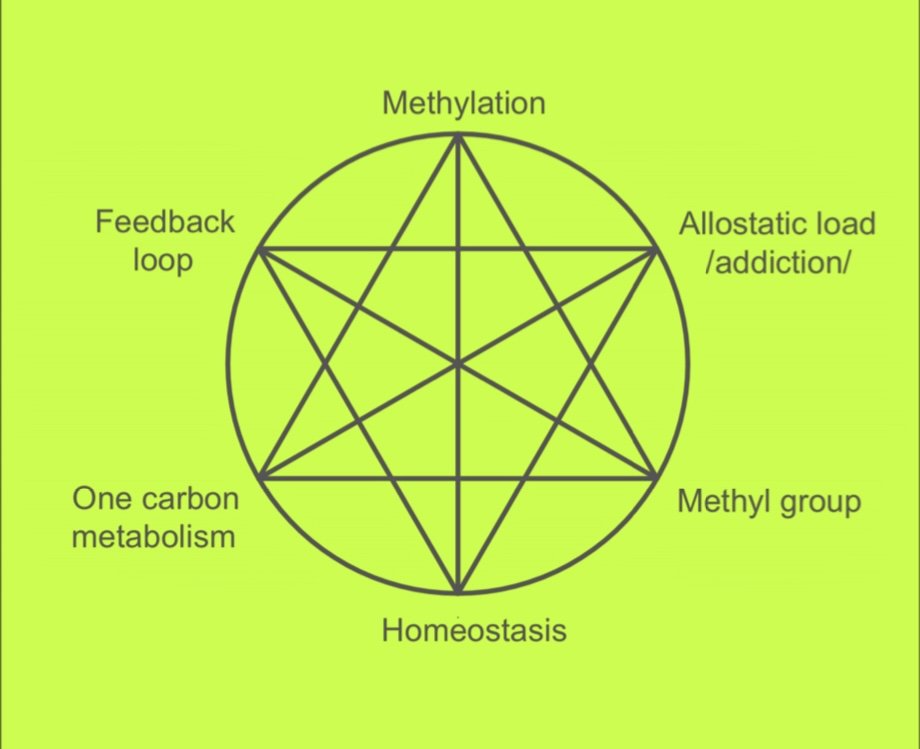
The Final Answer to Addiction
Addiction is a repetitive behavior — but why does it happen, and how?
We often hear about “the cycle” — the way the body metabolizes everything it takes in and sends out. Inside these cycles, two forces are always present: one that regulates the process, and one that disrupts it. This is actually the spiral where both forces work together as one. But when one of these forces becomes disturbed, the cycle turns into a vicious cycle.
The diagram below, which I personally designed after extensive research, illustrates the cycle of opposing forces that regulate — or disrupt — metabolic balance in the body. From biochemistry and beyond, we’ve learned that homeostasis, the balance between opposing forces, allows life to adapt and function smoothly in response to environmental stimuli.
The diagram is based on two interlocking triangles. Each pair of opposing angles represents a biological contradiction.
At the foundation, we start with homeostasis and methylation. Methylation is essential: it repairs DNA, switches genes on and off, aids detoxification, produces neurotransmitters, and ultimately fuels the body’s energy production.
The next pair: one-carbon metabolism vs. allostatic load (addiction). Why are these in conflict? Because most addictive substances — caffeine, nicotine, sugar, alcohol, pesticides, petroleum additives — contain methyl groups, the very same chemical units processed by one-carbon metabolism. The overload of synthetic methyl groups leads to dysregulation of this metabolism.
In lab tests, this often appears as high levels of the amino acid homocysteine — a clear signature of overstimulation. Think of it as an overloaded condition. The body craves balance, but it’s being pulled off course.
This is a state where the body craves regulation — and it craves it immediately.
But why is this urgency so extreme?
The answer lies in time regulation. Most metabolic processes in the body follow step-by-step pathways — linear, predictable, and gradual. But one-carbon metabolism, especially methylation, works differently. It bypasses the usual timing. It operates in real time, adjusting instantly to environmental demands.
This urgency is represented in the third pair of angles in the diagram, where feedback loops involving methyl groups play a critical role. Through years of research, I’ve discovered something consistent: nearly all stimulants — caffeine, nicotine, sugar, alcohol, pesticides, organophosphates, petroleum-based additives — contain synthetic methyl groups.
These synthetic compounds mimic natural biological methyl groups but disrupt the body’s internal regulation by hijacking the methylation cycle. The body can no longer distinguish between what’s natural and what’s artificial.
And cravings? They don’t follow a pattern. They arise whenever the body needs to respond genetically — whenever it must switch genes on or off in response to a need.
One specific genetic marker that plays a key role in this process is known as C677T — a variant of the MTHFR gene. This gene affects how efficiently methylation occurs. For some people, this single mutation can be the tipping point between stability and chronic craving.
So where do we go from here? How do we make it through?
This is a core piece of what I’ve found. The rest, I invite you to explore through the work I’ve dedicated to uncovering it.
The Medicine approach
For years, both Western and Eastern medicine have tried to solve this uncontrollable craving.
Western medicine tries to control biological energy by using the same forces that are already dysregulating it — like adding methyl groups through antidepressants, vitamin B6, B12, folic acid, and other powerful drugs. In essence, it attempts to fight overstimulation with more stimulation.
Eastern medicine aims to calm the nervous system and soothe impulsive neurotransmitter activity — like dopamine surges, brain fog, or chronic stress. Practices like yoga, for example, were never meant to be just a one-hour class; they were designed as a complete way of life — physical, mental, and spiritual alignment. But in the West, much of that depth was lost. It’s like calling yourself a Christian because you go to church, but not living by the values it teaches. In the same way, Western culture embraced mostly the surface of yoga, but not the inner transformation it was meant to bring.
But neither approach has fully succeeded.
Why? Because the problem isn’t entirely inside the body — it’s in the environment.
We live in a hyper-stimulated, artificial reality. And in this environment, the body never gets the chance to restore itself or build fresh energy.
Decades ago, stimulants were occasional — a cigarette here, a cup of coffee there. They weren’t embedded into daily life. But now, look around: nearly everything is stimulation. Not natural — but artificial. Designed. Manufactured.
From cigarettes and vapes to endless coffee varieties, energy drinks, soft drinks, processed snacks, fast food, and synthetic additives — the list keeps growing. These aren’t just habits. They are systems — produced, packaged, and consumed by us… but not for us.
So tell me — am I wrong to call this system a Tetrahedral Artificial Reality, built on repetitive behavior — addiction?
Why tetrahedral? The answer lies in the structure of my research, where this four-sided model reveals the hidden architecture of addiction, metabolism, and energy dysfunction.

